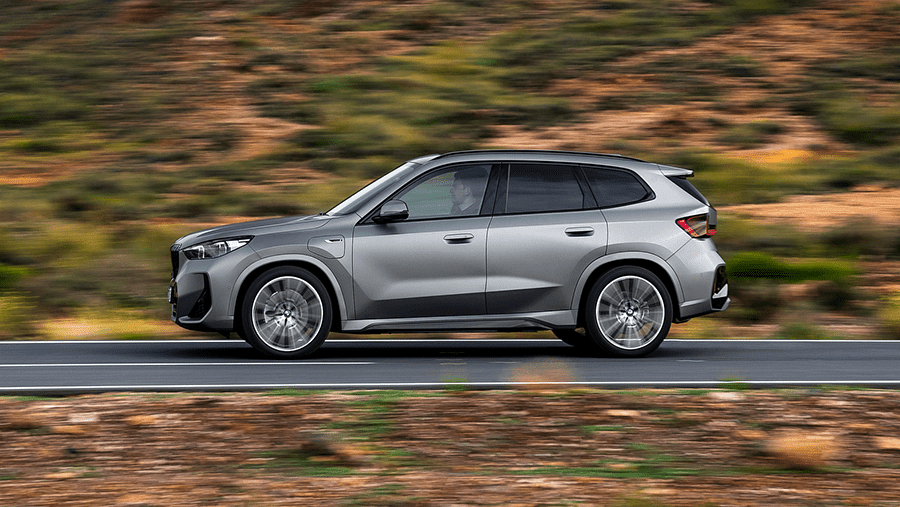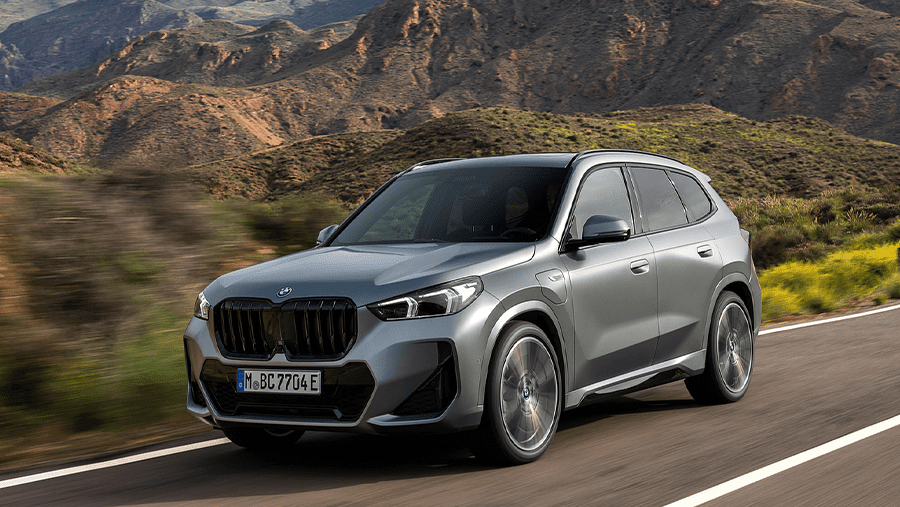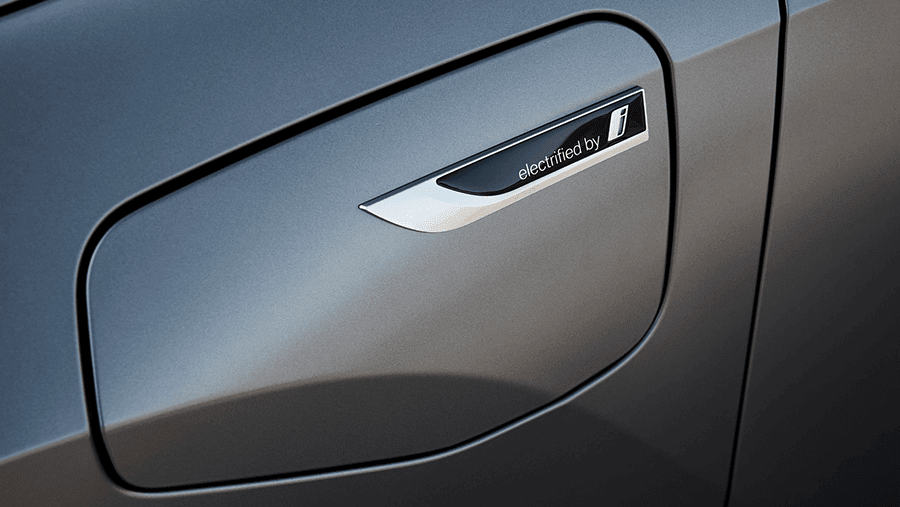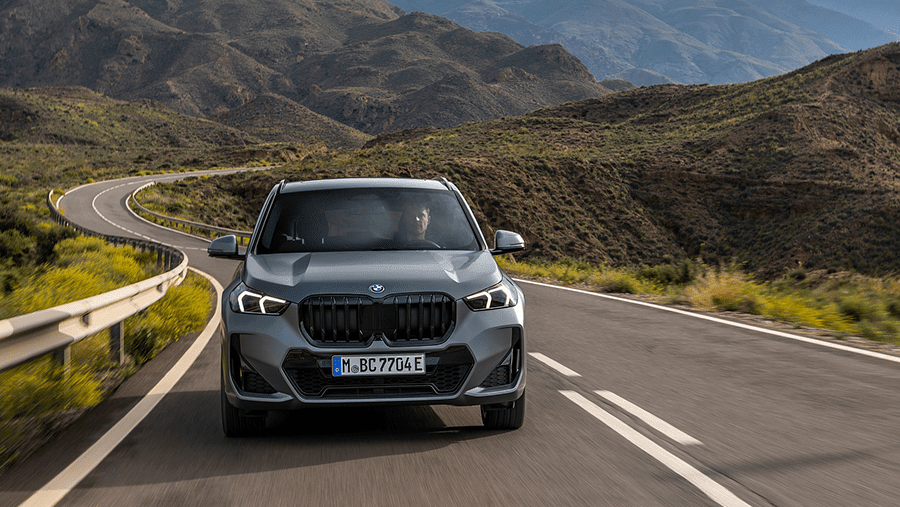
BMW X1 Review & Pricing

Introduction
The BMW X1 has undergone quite a significant overhaul since it first rolled off the production line nearly 15 years ago.
In fact, if you saw an original X1, you'd think it was just a glorified 1-Series with some off-road styling.
Compared with its bigger siblings, the X3 and X5, the X1 just lacked something – it didn't look like it belonged in the same line-up.
But, after bridging the gap with the second generation, the third generation has arrived.
The X1 is now bigger and bolder; first impressions are that it should be taken far more seriously as an SUV.
Although it’s the fossil-fuelled version we’re interested in here, part of the size increase over the outgoing model is to accommodate electric motors for the launch of its all-electric counterpart, the iX1, which goes on the market soon.
So, how does the new BMW X1 shape up?
Select's rating score* - 4 / 5
At A Glance
The front of the latest BMW X1 looks significantly upsized and courageous, with nostril-like kidney grilles, which are much larger than before.
While they aren’t the double-height kidney grilles which extend right down to the bottom, like on the all-electric iX SUV, they give the front end far more presence.
It is a very shapely design, accommodating a wide lower grille and bodywork along the bottom, which almost looks like a bar running horizontally. The headlights have been thinned out, giving the BMW a mean, aggressive frown.
Around the sides, the bottom of the doors bend inwards, leaving a small step above the side skirts, while there’s the slightest bulge around the wheel arches.

The rear is also squared off at the sides, with a black panel giving the BMW a muscular-like appearance.
It is a transformational look for the BMW X1, which has gone from a modest also-ran to a credible, athletic SUV more than capable of holding its own.
The looks differ slightly depending on which trim you pick, and the top-of-the-range M Sport model carries much of the aggression.
Nevertheless, all trims look the part.
If it goes as well as it looks, we could be on to a winner.

Key Features
There are three trims on offer: Sport, xLine and M Sport.
The Sport comes with 17-inch alloys, two 10.7-inch and 10.25-inch screens for the infotainment and digital cockpit display, an automatic tailgate, dual-zone climate control, a sports leather steering wheel, LED lights and a host of safety systems.
The xLine gets 18-inch alloys, black perforated seats, a high-gloss black interior trim and grey mirror caps.
The M Sport has 19-inch alloy wheels, Alcantara and Sensatec black upholstery with blue stitching and aluminium interior trim, and adaptive suspension.

In terms of powertrains, there’s a choice of petrol, diesel or plug-in hybrid power.
The Sport trim offers two 2.0-litre four-cylinder engines: the sDrive20i petrol with 170PS, while the diesel sDrive18d comes with 150PS.
There is also the xDrive25e, a 245PS plug-in hybrid.
The xLine grade offers all the above but also unlocks two more 2.0-litre four-cylinder engines: the 211PS xDrive23d diesel and another petrol, the 218PS xDrive23i, plus a second plug-in hybrid model, the xDrive30e with 326PS.
These powertrains are all available on the M Sport variant, too.
If you're familiar with BMW jargon, you'll know that the sDrive models are all front-wheel drive, while the xDrive models are four-wheel drive.

Performance & Drive
One thing we can say about the BMW X1’s engines is they’re all capable.
Even the lowly entry-level sDrive18d can get it from 0-62mph in less than nine seconds and is perfectly capable of making good progress. However, you'll shave the best part of two seconds off the above time if you pick the xDrive23d instead.
While the diesels are great for towing due to their torquey low-rev grunt, the petrols also have a lot to offer.
The entry-level sDrive20i pulls well off the line, getting from 0-62mph in 8.3 seconds, quicker than the entry-level diesel.

The plug-in hybrids perform exceptionally well, too. Sure, they may be overkill in terms of power output, but their fuel economy and low emissions make them ideal candidates for company car drivers.
We have been in a couple of cars in xLine, and M Sport trims, both with the petrol xDrive23i, which has a decent mid-level of performance at 218PS, getting from 0-62mph in a perfectly acceptable 7.1-seconds.
It moves away with aplomb, helped by the four-wheel drive system, and never feels short on power, thanks to the refined eight-speed dual-clutch automatic, which is responsive and changes quickly.
It features in all models across the range, and there's no manual gearbox available.

You get some mild-hybrid technology, which will cut the engine when coasting and when stationary Indeed, the engine never feels under strain, even when flooring the throttle.
It is somewhat unexciting, although burying the accelerator off the line results in a pleasing level of performance for an SUV. Still, this engine is the pick of the range due to its reasonably impressive fuel economy unless you're a long-distance driver and need the additional economy of a diesel or the tax savings of the PHEV.
It is quieter than the other powerplants in the range, too.
In terms of handling, the X1 impresses, considering its larger size, helped by the adaptive suspension, which is standard in the M Sport, but not on the other trims.
It means the suspension can be made softer and firmer depending on which driving mode you're in so that enthusiasts can stick it in Sport mode, while those wishing to protect their backs are also catered for.

However, generally speaking, the X1 has a reasonably firm setup and is less forgiving than its rivals without approaching anything that could be considered uncomfortable.
You will find the odd pothole will cause a bit of a thump, and the X1’s competitors tend to be more comfort-focused, albeit at the expense of handling.
The X1, on the other hand, tries to retain a sense of excitement for the driver, so while it can’t match its foes for suppleness, it feels far more athletic in the bends.
There is plenty of grip, and although some body lean is inevitable in an SUV, it's well-contained.
Disappointingly, the steering doesn't weight up sufficiently around corners to give you enough feedback to enable you to judge whether to hang back or push on.

Running Costs & Emissions
The petrol sDrive20i manages 46mpg, emitting 138g/km of CO2, while the more powerful xDrive23i returns 43mpg and 146g/km of CO2.
Unsurprisingly, fuel economy improves in the diesels to 55mpg and 134g/km of CO2 in the sDrive18d. However, the xDrive23d is potentially more economical, returning 58mpg and 128g/km of CO2.
They are all light years off the figures for the plug-in hybrids, which astonishingly manage 404mpg in the xDrive25e and 353mpg in the xDrive30e.
Both PHEVs emit just 18g/km of CO2, while both have an all-electric range of 55 miles, significantly more than their adversaries. You can find out more about how official range will translate to the real world in our guide!

There are no prizes for guessing which one attracts the lower company car tax, with the plug-in hybrids in a far lower band than the rest of the range.
In terms of reliability, BMW's past reputation for dependability is long gone, and it generally hangs around mid-table nowadays.
Just for information, the X1 only comes with a three-year warranty, although it's unlimited mileage, while the plug-in hybrids have their batteries protected by a longer warranty.

Interior & Technology
The BMW’s interior looks lovely and inviting. But, although its appearance tempts you to part with your cash, it still isn't as sophisticated as BMW's larger SUVs, such as the X7.
That is understandable, though, given the X7 is so much more expensive and appealing to a far more upmarket customer.
The M Sport test model features lots of aluminium which brightens things up.

There is certainly a futuristic impression to the interior, with the two 10.25 and 10.7-inch screens sitting next to each other in the same unit, curving slightly towards the driver, creating a pleasing cockpit-like feel.
The infotainment system, which has the latest Operating System 8, is impressive. But then we expected no less, as BMW has led the way in this field for the last few years.
It is ultra-responsive, crystal clear and reasonably easy to use, with sophisticated graphics.
One notable absentee, though, is BMW’s famed iDrive rotary controller, which is regrettably not included.
BMW's reasoning is that because you sit higher up in the X1, the touchscreen is easier to reach, so the controller isn't needed.

True, it is easier to reach – but the lack of a rotary controller means you need to take your eyes off the road to focus on what you’re touching on the screen.
BMW's answer to that is to use the voice control. And, yes, it's one of the most impressive voice-activated systems we've used, but it's by no means flawless.
This, added to the fact that there are no physical buttons for the climate control, makes for a slightly frustrating experience.
Overall, the BMW’s interior is short on luxury but retains excellent build quality, plush materials and a premium feel.

Practicality & Boot Space
Getting into the driver’s seat, you’ll notice the driving position is higher than you'd expect, but then, as we said earlier, the X1 is bigger nowadays.
Finding a comfortable position is simple enough, as there's plenty of adjustment in the steering wheel and seat, which is absorbing and has a decent amount of support at the sides. But, disappointingly, adjustable lumbar support isn’t included as standard.
The pillars at the front aren’t especially wide, so you have a generally unobstructed view of the road ahead and to the sides. But they’re much thicker at the back due to the diagonal angle of the rear window.
As a result, it’s a good thing that front and rear parking sensors, along with a reversing camera, are included across the range as standard.

You won’t be short on space, especially in the front. It is less generous in the rear but still perfectly adequate for two adults. Three grownups will be a tight squeeze for all but the shortest of trips.
If fitting three adults in the back is a regular occurrence, you'll need to look at one of BMW’s larger SUVs, such as an X3 or X5.
Mind you, although the rear bench doesn't slide, this can be added as an optional extra if you need more backseat space.
Headroom is acceptable in all seating positions, and, in fact, the X1 – thanks to its larger proportions nowadays – is arguably the class leader for this now.
In the front, you'll also notice that the centre console doesn't extend all the way forwards, so it doesn't directly connect to the dashboard, which leaves some vacant space for two cupholders.

This is where we find the wireless phone charger in the M Sport, as the top-of-the-range trim gets this included as standard, although it’s an optional extra on the Sport and xLine variants.
Storage space is plentiful, too, with generously sized door bins and a fairly accommodating glove box.
Boot space is an impressive 540 litres. You can expand this significantly by pulling levers in the boot, which fold down the rear seats in a convenient 40:20:40 split rather than the more common and less versatile 60:40 configuration.
Even more impressively, the plug-in hybrid models barely lose space, measuring around 530 litres.
Most PHEVs usually face a far more significant reduction in cargo capacity.

Safety
The new BMW X1 has already been put through its paces by crash-testing specialists at Euro NCAP, earning a five-star rating.
It scored 86 per cent for adult occupants, 89 per cent for children, 76 per cent for vulnerable road users such as pedestrians, and an impressive 92 per cent for safety assists.
Safety gadgetry includes automatic emergency braking, a parking assistant with front and rear parking sensors and reversing camera, plus cruise control with brake function, which maintains the gap to the vehicle in front of you.
A lot more safety systems are offered as optional extras through the Driving Assistant Professional pack, which we’ll come on to shortly.

Options
The entry-level Sport models come with 17-inch alloys, which can be upgraded to 18 inches if you want larger ones.
Likewise, the xLine is 18 inches as standard, with 19 and even 20-inch rims available if you're happy to pay more, while the M Sport gets 19 inches as standard, upgradable to 20 inches.
There is a wide variety of body colours, too, from light grey to orange. In addition, there are various interior colours for the seats and upholstery, including dual-colour options featuring cream or red.
Other optional extras include a head-up display, folding door mirrors, a heated steering wheel, electric front memory seats, heated seats and adaptive LED headlights.

If that's not enough, an automatic high beam, wireless charger, sliding rear seats, a Harman Kardon surround sound system, and panoramic glass sunroof is also available.
Most of these can be bought as part of packs, reducing the price of buying them individually.
The Technology Plus pack includes many of the features above. At the same time, the Driving Assistant Professional Pack adds several safety systems, including traffic sign detection, blind-spot assist, rear cross-traffic alert and lane-keeping assist.

Rival Cars
If you're after a small SUV, you may have yet to consider Genesis. Still, its GV70 is incredibly absorbing, offering a more comfortable ride, even though the driving experience isn’t as refined as the BMW X1.
It does include a rotary dial to control the infotainment system, however.
Other alternatives that should be on your leasing list include the Volvo XC40 and the now slightly tired Range Rover Evoque.

All have higher driving positions than the X1. However, the X1 has a bigger boot than the XC40 and Evoque and is about the same as the Audi Q3 and GV70.
A Mercedes-Benz GLA is also worth looking at, along with Audi's Q1 and Q2.
If your heart is set on a BMW, but the X1 is too small, the X3 and X5 offer larger alternatives.

Verdict & Next Steps
Overall, the latest BMW X1 is a transformative step in the right direction for a car that didn't really fit when it was first launched in 2009.
It is bigger, bolder and looks like a fully-fledged SUV rather than something that, as with the first-generation model, is trying to be something it isn’t.
Nowadays, the X1 offers excellent practicality for its size, lots of room inside, economical powertrains – superbly so in the case of the plug-in hybrids – and it's well equipped as standard. However, it's likely most will pick an item or three from the options list.
Rivals have a more supple, absorbing ride, and the lack of a rotary dial is frustrating, especially given the air conditioning controls having been absorbed by the infotainment touchscreen.
Nevertheless, the latest BMW X1 is no longer a pretender: finally, it’s a contender.
Where to next?
View our latest BMW X1 Leasing Deals - from just £423.12 per month inc VAT**
Looking for a great leasing deal? Check out our incredible range of Special Offers
New small SUV? Read our latest Car Reviews and find the right model for you
Want to know more about leasing? Take a look at our comprehensive Leasing Guides
Interested in everything motoring? Why not catch up on all the latest Car Leasing News.
*Score based on Select’s unique meta score analysis, taking into account the UK’s top five leading independent car website reviews of the Volkswagen ID.5
**Correct as of 29/11/2022. Based on 9 months initial payment, 5,000 miles over a 48 month lease. Initial payment equivalent to 9 monthly payments or £3,808.08 Ts and Cs apply. Credit is subject to status.




















